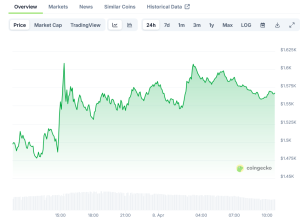Key Insights
- In Q1 2022, Livepeer processed over 33 million minutes of transcoded video, up 12% from the previous quarter.
- Node operator revenue in ETH grew 22% (decreased 13% in USD terms due to the overall market downturn).
- Revenue from LPT staking rewards grew 18% (decreased 12% in USD terms).
- Since Livepeer’s migration to Arbitrum, operating on the network has become feasible for smaller players as fees decreased ~97%.
- Livepeer is looking to expand its service offering with in-video object recognition and scene classification capabilities.
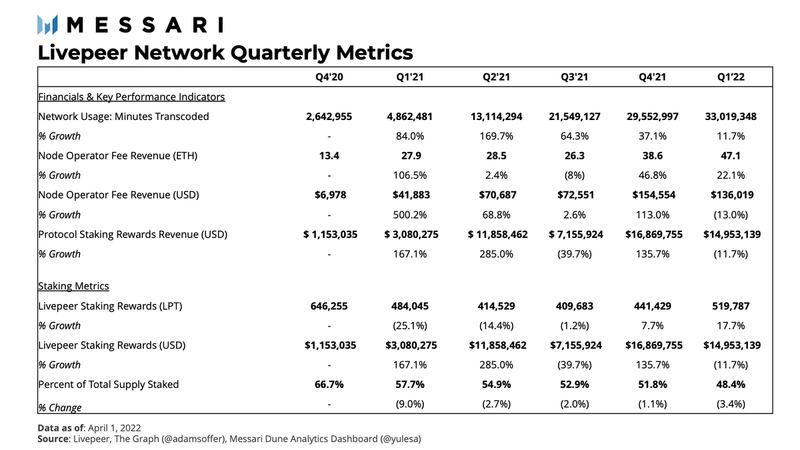
Livepeer in a Nutshell
Building decentralized video apps like Twitch or TikTok requires heavy infrastructure for streaming. Based on the user’s bandwidth and device, video content needs to be processed into viewable formats. This process is called transcoding and is used, for instance, every time when watching a live event on a smartphone.
While cloud providers like AWS, Google, or Microsoft are commonplace solutions for video transcoding services, they incur high costs. Livepeer is an open marketplace for decentralized video infrastructure that aims to reduce the cost of video streaming by 10x.
The main stakeholders within the Livepeer network are node operators, transcoders, and delegators.
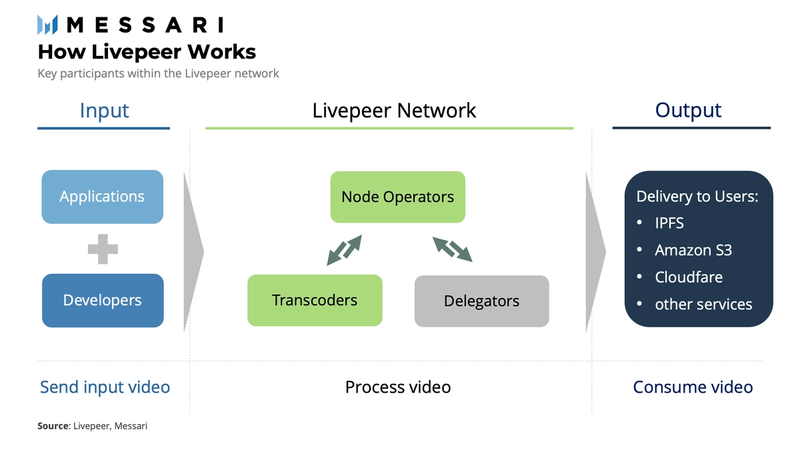
Node operators – called “orchestrators” in Livepeer – supply video transcoding services to applications and developers. Node operators receive raw video content as input and are responsible for returning transcoded results. To perform these services, node operators must stake the native Livepeer asset, LPT. The more LPT a node operator stakes, the more work it can perform on the Livepeer network.
Transcoders provide the computational resources for node operators to perform video transcoding. Essentially anyone with idle GPU computing capacity can run Livepeer software as a transcoder to facilitate video streaming and earn fees in return. Given that not every transcoder operates a node on the Livepeer network, transcoders may choose to allocate their computational resources to node operator pools.
Delegators are individuals and entities that stake LPT with node operators. By design, delegators choose to route stake to the most effective nodes, in exchange for a portion of ETH fees and newly minted LPT.
Usage at All-Time-High
Demand for Livepeer services comes from applications and developers in need of video transcoding services. For example, user-generated content applications require streaming infrastructure to broadcast videos to followers. These applications pay node operators a fee in ETH for transcoding services. Livepeer’s network usage can be gauged by how many minutes of video are transcoded.
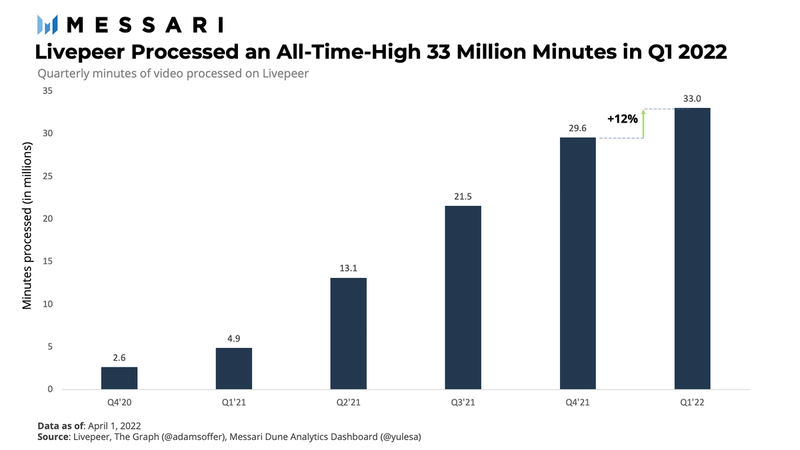
Q1 2022 saw a record of over 33 million minutes of transcoded video processed on the Livepeer network. This is a 12% increase from the previous quarter, which also saw an all-time-high. In fact, Livepeer’s network usage achieved all-time-highs in each of the last six quarters, demonstrating a healthy demand for Livepeer video transcoding services.
This growth has the potential to continue. Increased demand for Livepeer transcoding services may come from Web3-enabled video applications, e.g., video NFT minting or token-gated access to streaming. Livepeer aims to further increase its protocol usage for 4k video and expand into other business verticals, as discussed in the “Roadmap: Beyond Transcoding” section.
Network Revenue
Node operators ensure that the supply of video transcoding services meets the demand of applications. Delegators help route work to the most effective nodes by committing stake to node operators. In addition, supply-side revenue in Livepeer consists of revenue from fees for transcoding services and from staking rewards.
Transcoding Revenue
Fees from transcoding services are paid to node operators in ETH and distributed to transcoders, node operators, and delegators. As node operators stake more LPT, they increase their likelihood of receiving more work, which results in earning more transcoding fees. Delegators assign their stake to node operators, as a quality assurance mechanism that routes work to effective nodes.

Livepeer transcoding fee revenue increased by 22% in ETH terms in Q1 2022. This growth in service fee revenue directly corresponds to the growth in the Livepeer network usage. However, due to the overall market downturn, the USD equivalent of the transcoding fee revenue in Q1 2022 ($136,000) decreased 13% relative to Q4 2021 ($154,000). That said, it is still 84% higher than Q3 2021 ($74,000).
Despite the recent growth, transcoding revenue is relatively insignificant compared to staking reward revenue (as discussed below). Like other Web3 infrastructure protocols, the Livepeer network subsidizes its node operators with LPT rewards. This subsidization enables the Livepeer protocol to compete with existing transcoding providers like Amazon and Google.
As per Messari’s recent analysis of Web3 infrastructure revenue, Livepeer’s transcoding fee revenue can be evaluated according to its total addressable market: while still relatively small, transcoding revenue is growing proportionally with usage. Considering the steady growth in the number of transcoded minutes, Livepeer is well-positioned in a market with significant upside potential.
Staking Revenue
To provide transcoding services on the Livepeer network, node operators must stake LPT. In turn, Livepeer distributes rewards in LPT to node operators and delegators.
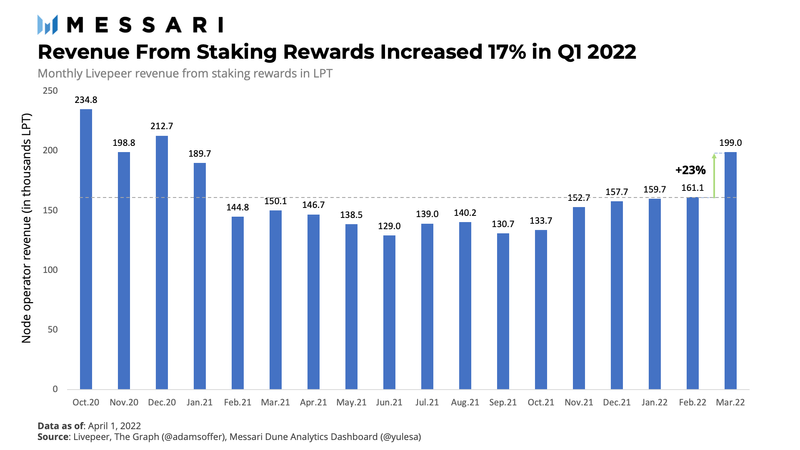
Staking reward revenue in LPT terms increased 17% in Q1 2022. However, due to the overall market downturn, the USD equivalent of the staking reward revenue in Q1 2022 ($15 million) decreased 12% relative to Q4 2021 ($16.7 million). Even so, it is still 108% higher than Q3 2021 ($7.2 million). Interestingly, March 2022 (199,000 LPT rewarded) posed a 23% increase relative to February 2022 (161,000 LPT).
LPT staking reward issuance is dynamic: it’s based on the participation rate, which is the percentage of the circulating supply that is staked. If the participation rate falls below 50% in a given round, LPT inflation increases by 0.00005%, incentivizing tokenholders to commit stake to the Livepeer network. Conversely, if participation passes 50%, inflation decreases by 0.00005%.
Our previous quarterly report found that the Livepeer network had managed to incentivize network participants to approach the equilibrium of 50% participation. A follow-up question is whether this pattern holds after the network’s migration to Arbitrum in mid-February 2022, upon node operators and delegators moving their stake to Layer-2.

During the migration, a sharp drop occurred, followed by a rebound to near 50% participation. The sharp drop in the participation rate was accompanied by an increase of 23% in LPT token issuance inflation in March 2022 (0.8%) versus February 2022 (0.65%).
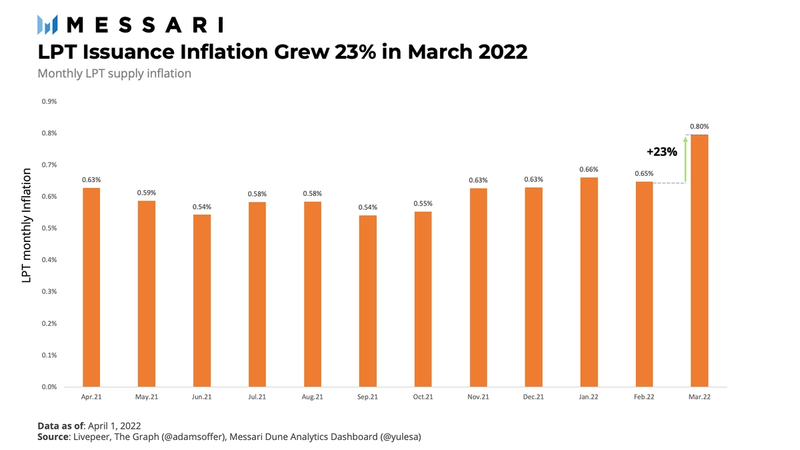
Should the participation rate continue to stabilize at or below 50%, inflationary issuance will gradually increase.
Post-Migration Takeaways
Livepeer’s migration to Arbitrum was successful in several ways. Prior to the migration, nodes needed to attract over 50,000 staked LPT with a reward cut of at least 25% to reach profitability. The migration has allowed for increased flexibility, as seen in the change in the frequency of delegator staking/unstaking.

The Arbitrum migration took place in round #2466, marking 6,569 moved stake. Excluding round #2466, exactly 100 rounds took place throughout Q1 2022: 49 Ethereum rounds before the migration (average moved stake: 120 per Ethereum round), and 50 Arbitrum rounds after the migration (average moved stake: 9,312 per Arbitrum round).
However, rounds #2476 to #2496 on Arbitrum had an average of 17,961 moved stake per round, which is 93% higher than the post-migration average moved stake between February 16 and March 31 2022. After round #2496, the movements begin to settle down. This settling down could signal the return to normal activity after an initial “moving rush” following the migration.
To account for this “moving rush,” we compare the last full month of operation on Ethereum (January – average moved stake: 120 per Ethereum round) to the first full month on Arbitrum (March – average moved stake: 7,179 per Arbitrum round). Although a bleed of the initial spike in Arbitrum movement occurs into the start of March, there’s a 60x increase in moved stake.
This increase might be explained by the lower transaction fees per operation on Arbitrum: allowing stake to be routed through the network, serving its purpose of being delegated to reliable network operators. What’s more, network users saw an immediate increase in profitability. Since the migration, operating on the network has become feasible for smaller players as fees have reduced by ~97%.
Livepeer Ecosystem: Notable Events
$20 Million Series B-1
Livepeer Inc. raised a $20 million B-1 series in January 2022. In line with the company’s plans to progressively decentralize, this funding will be used for initiatives that increase functionality and serve a larger number of video applications. Altogether, Livepeer Inc. has raised $51 million to support ecosystem growth since its inception in Q3 2019.
Arbitrum Migration
Overcoming rising Ethereum gas fees has been a key concern for Livepeer. Claiming fees and staking rewards has cut into supply-side revenue, negatively impacting existing network participants and network operator traction. Livepeer’s backward incompatible migration to Arbitrum went live with the Confluence upgrade on February 14, 2022. Since then, more than half of the total LPT supply has migrated to Layer-2. Inflationary rewards are now minted, and ETH fees are solely distributed on Arbitrum.
Expanding Community Presence
To stimulate network usage demand, Livepeer has sponsored various hackathons such as Web3con, NFTHack, and ETHRio. Q1 2022 saw a total of 72 projects funded to build Livepeer-enabled apps and services.
Notable projects include a token-gated streaming service (Glitch), a Web3 video library (LensTube), a decentralized Twitch (Imbue), and a livestream video NFT minting platform (ColorPixels). These projects join other operational video applications that leverage the Livepeer network including DJ streaming service PlayDJ and live shopping video solutions powered by Korkuma.
Further funds have been granted to builders of tooling for node operators, staking, and governance. An additional $250,000 grants program focused on driving network demand is planned for Q2 2022.
Roadmap
The Q2 2022 roadmap includes several technical and product upgrades aimed to decrease network-wide transcoding latency as well as to explore opportunities beyond transcoding.
Technical and Product Updates
To decrease verification latency, Livepeer’s Fast Verification Procedure, partially implemented in Q4 2021, will roll out fully in Q2 2022. The Fast Verification Procedure aims to streamline the process of verifying that videos are transcoded appropriately by easing the verification burden on applications.
The introduction of network-wide fast verification is paving the way to increase or entirely remove the present orchestrator limit of 100 nodes, allowing more participants to verifiably contribute work on the network. Later, Full Verification will complement Fast Verification by reintroducing network slashing and on-chain dispute resolution mechanisms.
In terms of user experience, the Livepeer Explorer is expected to expand usage and performance metrics as well as optimize the stake routing experience between node operators.
Beyond Transcoding
Livepeer is looking to expand its service offering to include more use cases for GPUs beyond video transcoding. In 2022, Livepeer plans to introduce object recognition and scene classification capabilities.
Object recognition can offer e-commerce experiences through features like automatically recognizing in-video entities, making them clickable, and enhancing them with metadata. Scene classification algorithms that classify and tag specific types of content, such as violent or adult content, can help with content moderation. Looking forward, video fingerprinting and song title recognition are additional use cases for Livepeer, which may use NFTs to prove ownership of video content and help mitigate potential copyright infringement.
Closing Summary
Livepeer aims to become the video infrastructure layer for both Web3 and traditional applications. To achieve this goal, Livepeer is refining and expanding its support for video services beyond transcoding. At the same time, Livepeer is considering stablecoin payments and ways that it can support cross-chain demand. Should Livepeer succeed at onboarding sufficient demand interest and decreasing overall transcoding latency, they stand a chance to become a prominent infrastructure player for video streaming services.
This report was commissioned by Livepeer, a member of Protocol Services. All content was produced independently by the author(s) and does not necessarily reflect the opinions of Messari, Inc. or the organization that requested the report. Paid membership in Protocol Services does not influence editorial decision or content. Author(s) may hold cryptocurrencies named in this report.
Crypto projects can commission independent research through Protocol Services. For more details or to join the program, contact ps@messari.io.
This report is meant for informational purposes only. It is not meant to serve as investment advice. You should conduct your own research, and consult an independent financial, tax, or legal advisor before making any investment decisions. Past performance of any asset is not indicative of future results. Please see our terms of use for more information.

